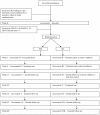Prevention of depression and anxiety in adolescents: a randomized controlled trial testing the efficacy and mechanisms of Internet-based self-help problem-solving therapy
- PMID: 19821984
- PMCID: PMC2771008
- DOI: 10.1186/1745-6215-10-93
Prevention of depression and anxiety in adolescents: a randomized controlled trial testing the efficacy and mechanisms of Internet-based self-help problem-solving therapy
Abstract
Background: Even though depression and anxiety are highly prevalent in adolescence, youngsters are not inclined to seek help in regular healthcare. Therapy through the Internet, however, has been found to appeal strongly to young people. The main aim of the present study is to examine the efficacy of preventive Internet-based guided self-help problem-solving therapy with adolescents reporting depressive and anxiety symptoms. A secondary objective is to test potential mediating and moderating variables in order to gain insight into how the intervention works and for whom it works best.
Methods/design: This study is a randomized controlled trial with an intervention condition group and a wait-list control group. The intervention condition group receives Internet-based self-help problem-solving therapy. Support is provided by a professional and delivered through email. Participants in the wait-list control group receive the intervention four months later. The study population consists of adolescents (12-18-year-olds) from the general population who report mild to moderate depressive and/or anxiety symptoms and are willing to complete a self-help course. Primary outcomes are symptoms of depression and anxiety. Secondary outcomes are quality of life, social anxiety, and cost-effectiveness. The following variables are examined for their moderating role: demographics, motivation, treatment credibility and expectancy, externalizing behaviour, perceived social support from parents and friends, substance use, the experience of important life events, physical activity, the quality of the therapeutic alliance, and satisfaction. Mediator variables include problem-solving skills, worrying, mastery, and self-esteem. Data are collected at baseline and at 3 weeks, 5 weeks, 4 months, 8 months, and 12 months after baseline. Both intention-to-treat and completer analyses will be conducted.
Discussion: This study evaluates the efficacy and mechanisms of Internet-based problem-solving therapy for adolescents. If Internet-based problem-solving therapy is shown to reduce depressive and anxiety symptoms in adolescents, the implication is to implement the intervention in clinical practice. Strengths and limitations of the study are discussed.
Trial registration: Netherlands Trial Register NTR1322.
Figures
References
-
- Lewinsohn P, Rohde P. The cognitive-behavioral treatment of depression in adolescents: Research and suggestions. Clinical Psychologist. 1993;46:177–183.
-
- Roza SJ, Hofstra MB, Ende J Van der, Verhulst FC. Stable prediction of mood and anxiety disorders based on behavioral and emotional problems in childhood: A 14-year follow-up during childhood, adolescence, and young adulthood. Am J Psychiatry. 2003;160:2116–2121. doi: 10.1176/appi.ajp.160.12.2116. - DOI - PubMed
-
- Ge X, Lorenz FO, Conger RD, Elder GH, Jr, Simons RL. Trajectories of stressful life events and depressive symptoms during adolescence. Dev Psychol. 1994;30:467–483. doi: 10.1037/0012-1649.30.4.467. - DOI
-
- Sacco WP, Graves DJ. Childhood depression, interpersonal problem-solving, and self-ratings of performance. J Clin Child Psychol. 1984;13:10–15.
Publication types
MeSH terms
LinkOut - more resources
Full Text Sources
Medical



